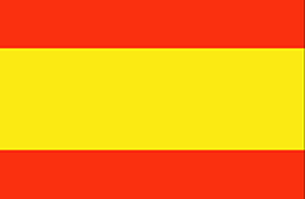SPAIN

The Iberian Peninsula has been inhabited since the Stone Age – approximately 35,000 years ago. The Celts invaded the area that is now Spain in the 1st millennium BC and mingled with the native Iberians. The Phoenicians and Greeks established colonies along the coasts, then the Carthaginians conquered Spain in the 3rd century BC. The Romans expelled the Carthaginians around 200 BC.
As the Roman Empire declined, the Vandals and Visigoths assumed power in the 5th century AD. Then the Moors from Northern Africa invaded in the 8th century. Spain was gradually reconquered by the Christian kingdoms of Castile, Aragon, and Portugal. Spain was reunited in 1479 following the marriage of Ferdinand II of Aragon and Isabella I of Castile.
The last Muslim kingdom of Granada was reconquered in 1492 – the same time that Columbus sailed to the new world and claimed it for Spain. Spain established a vast empire over the next century.
The 16th century was the height of Spanish power, but that power slowly eroded during the 17th century. In the 18th century, Spain fought the War of Spanish Succession which resulted in the loss of many European possessions and sparked revolution in many of Spain’s American colonies. Then in the late 19th century, Spain lost its remaining overseas possessions to the US in the Spanish-American War.
Spain is comprised of 195,364 square miles in southwest Europe. It shares borders with France, Andorra, Gibraltar, and Portugal. It has water borders on the Mediterranean Sea and Atlantic Ocean. It also has enclaves on the African continent bordering on Morocco. Spain’s territory includes the mainland, the Balearic Islands, the Canary Islands, and the African enclaves of Ceuta and Melilla.
The government is a constitutional monarchy with two legislative houses. The king is the head of state, and the prime minister is the head of government. The capital is in Madrid.
For a cruising boat, Spain is readily grouped in to five areas that can be visited. These areas include the 1) north Atlantic coast, 2) Mediterranean coast, 3) Balearic Islands, 4) African enclaves, and 5) Canary Islands. Our plans include three of those areas – the Balearic Islands, the Mediterranean coast, and the Canary Islands. We did not visit the north Atlantic coast or the African enclaves.
We were in Spain’s Balearic Islands from August 3 to 14 We were on the mainland Mediterranean coast from August 14 till October 8. And we were in the Canary Islands from from October 12, 2012 until January 16, 2013.
Follow us to the Balearic Islands, mainland Spain, or the Canary Islands.